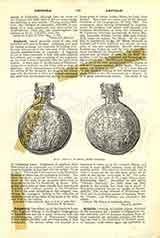

Ampullae. —Among the smaller objects discovered in the catacombs are a number of fragments of vessels ordinarily used for domestic purposes. Some of these fragments are, probably, portions of the drinking cups used in the celebration of the funeral agape, or banquet, while others again are the remains of vases which contained the unguents that the Christians, like the Jews and the pagans, often interred with the dead. A third class of vessels, ordinarily referred to as blood-ampullae, has been the subject of considerable speculation by archaeologists. Portions of these vessels have been found in the cement employed to enclose certain graves in the catacombs. Their peculiarity consists in the sediment of dark red color they contain, from which they derive the name, blood-ampullae, on the theory that the sediment is the remains of the blood of a martyr. This theory was for a time rather generally accepted, and the presence of a blood-vase was regarded as one of the marks of a martyr’s tomb. Martigny, however, in the second edition of his “Dict. des antiquites chretiennes” (Paris, 1877), expressed himself as dissatisfied with the proofs put forward by its supporters. Professor Kraus, also, in a work devoted to this subject, pronounced against the unconditional acceptance of the blood theory. The reasons for this conclusion are as follows: (I) the so-called blood-ampullae have been found on tombs of the latter half of the fourth century, a time when the era of persecution was long over; (2) the monogram of Christ, which in practically all cases indicates the age of Constantine, is frequently represented on tombs containing blood-ampullae; (3) a fifth of the tombs with ampullae of this class contained the remains of children under seven, and it is difficult to admit that so large a proportion of martyrs were mere infants; (4) a chemical analysis made at Greenwich of the contents of sixty ampullae has shown that the sediment contains a quantity of oxide of iron twenty, or more, times greater than would have existed in blood.
These results of later investigation are wholly negative, and the theories advanced in place of that formerly accepted are by no means satisfactory. Kraus regards vessels of this class as having been, as a rule, receptacles for holy water; in six instances, however, he thinks it probable that they contained blood. The Bollandist Victor De Buck conjectures that the wine left after the celebration of Mass was placed in them, but this view is not borne out by the Greenwich analysis. Leclercq concludes his researches in this matter by calling attention to the fact that ampullae have been found on Jewish tombs fastened in the same way as in the Christian cemeteries, in the catacombs of the Vigna Randanini and the Via Labicana. In relation to this subject two decisions of the Sacred Congregation of Rites are of interest. The first of them, given April 10, 1668, states that the palm on a tomb, and the blood-vase (vas illorum sanguine tinctum) are evidences of a martyr’s grave. The second decision, dated December 10, 1863, is formulated in substantially the same terms (Phialoe… sanguine tinctoe). These decrees require no modification, even at the present time; but it is now necessary to determine by chemical analysis whether the content of a vase is really blood or nt. The term ampulla was applied also to the vessels of terra-cotta, metal, or glass in which the holy oils ere kept (Optat. Mil., Contra Donatist., II, 19; ampula chrismatis). The “Sainte Ampoulle” used at the consecration of the kings of France in the Cathedral of Reims was an object of great reverence in medieval France (see Archdiocese of Reims), and was popularly believed to have been brought from Heaven by a dove at the baptism of Clovis (496). In the Cathedral of Monza are preserved several of the ampullae sent to Queen Theodolinda by Pope Gregory the Great they contained oil from the tombs of the most famous Roman martyrs. This custom of obtaining ampullae filled with oil from the lamps at the shrines of martyrs was generally observed in the Middle Ages those from the tomb of St. Mennas in Egypt, brought to Europe by pilgrims, are especially numerous. Ampullae usually bore the image or symbols of the saint from whose tomb the oil was obtained.

